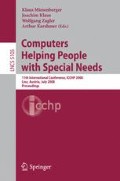Abstract
In this paper a natural human computer interaction paradigm is proposed for persons with cognitive impairments such as Alzheimer’s Disease. The paradigm consists of using a realistic virtual character, rendered on a common television set, to play the role of a virtual personal assistant that shows reminders, notifications and performs short dialogues with the user. In this paradigm, the television remote control is used as a return channel to capture the user’s responses. To test this concept, a functional prototype was built and then validated by a group of 21 persons with Alzheimer’s Disease ranging from mild to moderate. For this validation two simple dialogues were developed that consisted of simple Yes/No type questions. The test results showed that with both dialogues all users engaged naturally with the avatar. All of the users understood the information conveyed by the avatar and answered successfully by means of the TV remote control.
Access this chapter
Tax calculation will be finalised at checkout
Purchases are for personal use only
Preview
Unable to display preview. Download preview PDF.
References
Ríos, C., Pascual, L.F., Santos, S., López, E., Fernández, T., Navas, I., Casadevall, T., Tejero, C., Morales, F.: Working memory and complex activities of everyday life in the initial stages of Alzheimers disease. Revista de Neurología 33, 719–722 (2001)
Muñoz, J.: Síndromes cerebrales y envejecimiento. In: Muñoz, J. (ed.) Psicología del envejecimiento, Pirámide, Madrid, Spain, pp. 177–194 (2002)
Tuokko, H., Hadjistavropoulos, T.: An assessment guide to geriatric neuropsychology. Lawrence Eribaum, New Jersey (1998)
National Research Council: More than Screen Deep: Toward Every-Citizen Interface to the Nation’s Information Infrastructure. National Academy Press, Washington, USA (1997)
Elliot, R.: Assistive Technology for the Frail Elderly: An Introduction and Overview. U.S. Department of Health and Human Services. University of Pennsylvania, USA (1991)
Gregor, P., Newell, A.F., Zajicek, M.: Designing for dynamic university - interfaces for older people. In: Assets 2002, Edinburgh, Scotland, July 8-10, 2002, pp. 151–156 (2002)
Carretero, M.P., Oyarzun, D., Ortiz, A., Aizpurua, I., Posada, J.: Virtual characters facial and body animation through the edition and interpretation of mark-up languages. Computers & Graphics 29(2), 189–194 (2005)
Abascal, J., Nicolle, C.: HCI Guidelines for Elderly and Disabled People. Taylor & Francis, Inc., Bristol (2001)
ICT for Citizens and Businesses eInclusion FP6 Projects, http://cordis.europa.eu/ist/einclusion/projects.htm
Rodríguez, T., Fischer, K., Kingston, J.: Intelligent Services for the Elderly Over the TV. J. Intell. Inf. Syst. 25(2), 159–180 (2005)
i2home - Intuitive Interaction for Everyone with Home Appliances based on Industry, http://www.i2home.org
Schwalb, E.: iTV handbook: technologies & standards. Comput. Entertain. 2(2) (2004)
O’Driscoll, G.: The Essential Guide to Digital Set-Top Boxes and Interactive TV. Prentice Hall PTR, Upper Saddle River (1999)
Chorianopoulos, K., Lekakos, G.: Learn and play with interactive TV. Comput. Entertain. 5(2) (2007)
Nishida, T.: Conversational Informatics: An Engineering Approach. Wiley Series in Agent Technology (2005)
Prendinger, H., Ishizuka, M.: Life-Like Characters: Tools, Affective Functions, and Applications. Springer, Heidelberg (2004)
Beskow, J., Karlsson, I., Kewley, J., Salvi, G.: SYNFACE - A Talking Head Telephone for the Hearing-impaired. In: Miesenberger, K., Klaus, J., Zagler, W., Burger, D. (eds.) Computers helping people with special needs, pp. 1178–1186 (2004)
Oyarzun, D., Lehr, M., Ortiz, A., Carretero, M.P., Ugarte, A., Vivanco, K., García-Alonso, A.: Using Virtual Characters as TV Presenters. In: Proceedings of Edutainment 2007, Hong Kong, China. LNCS, vol. 4469, pp. 225–236. Springer, Heidelberg (2007)
Ugarte, A., Garcia, I., Ortiz, A., Oyarzun, D.: User interfaces based on 3D avatars for interactive television. In: Proceedings of the 5th European Conference on Interactive TV, EuroITV 2007, Amsterdam, The Netherlands (2007)
Ortiz, A., Carretero, M.P., Oyarzun, D., Yanguas, J.J., Buiza, C., González, M.F., Etxeberria, I.: Elderly Users in Ambient Intelligence: Does an avatar Improve the Interaction? In: Universal Access in Ambient Intelligence Environments. LNCS, vol. 4397, pp. 99–114. Springer, Heidelberg (2007)
Ortiz, A.: Avatares para la interacción emocional. In: PhD Thesis, Universidad del País Vasco (2008)
Carrasco, E., Göllner, C.M., Ortiz, A., Garcia, I., Buiza, C., Urdaneta, E., Etxaniz, A., González, M.F., Laskibar, I.: Enhanced TV for the Promotion of Active Ageing. In: Challenges for Assistive Technology AAATE 2007. Assistive Technology Research Series, vol. 20, pp. 159–163. IOS Press, Amsterdam (2007)
Reisberg, B., Ferris, S.H., De León, M.J., Crook, T.: The Global Deterioration Scale of Assesment of primary degenerative dementia. American Journal of Psychiatry 139, 1136–1139 (1982)
Mahoney, F.I., Barthel, D.W.: Functional Evaluation: The Barthel Index. Maryland State Medical Journal 14, 61–65 (1965)
Author information
Authors and Affiliations
Editor information
Rights and permissions
Copyright information
© 2008 Springer-Verlag Berlin Heidelberg
About this paper
Cite this paper
Carrasco, E. et al. (2008). Natural Interaction between Avatars and Persons with Alzheimer’s Disease. In: Miesenberger, K., Klaus, J., Zagler, W., Karshmer, A. (eds) Computers Helping People with Special Needs. ICCHP 2008. Lecture Notes in Computer Science, vol 5105. Springer, Berlin, Heidelberg. https://doi.org/10.1007/978-3-540-70540-6_5
Download citation
DOI: https://doi.org/10.1007/978-3-540-70540-6_5
Publisher Name: Springer, Berlin, Heidelberg
Print ISBN: 978-3-540-70539-0
Online ISBN: 978-3-540-70540-6
eBook Packages: Computer ScienceComputer Science (R0)

